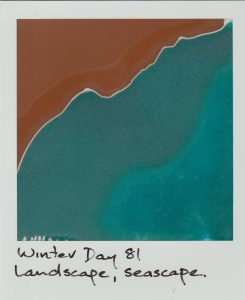About 92 Days of Winter
This work was developed on the lands and waterways of the Bunurong / Boonwurrung people of the Eastern Kulin. They are the traditional owners and first storytellers of this place. Their sovereignty was never ceded. It is, and will always be, Aboriginal land. I acknowledge and pay my respects to Aboriginal elders past, present and emerging.

92 Days of Winter is a mixed media experiment in embodied documentation of a local and personally familiar place – Cape Paterson, on Victoria’s south east coast.
- Read the mixed-media essay, Adrift in shallow waters: 92 days of winter swimming, walking & watching which was named as the winner of the 2021 Bass Coast Prize for Non-Fiction;
- View the 92 days of winter online collection
Each day of the 2020 COVID winter (and numerous times since) I left the warmth of home, meandered through sleepy streets, over the dunes, down to the same secluded stretch of sand that marks the threshold between shore and sea. Once there, I walked the vacant coastline, dove into the bracing cold and swam in the sea. Each and every day of that elongated winter, all ninety-two of them, I returned to the same place, in search of something different.
The shoreline I visited is a place of my adolescence and now my adulthood. Cape Paterson’s Bay Beach is an unobtrusive section of coast in the heart of a quiet seaside village. It is a place that elicits fuzzy recollections of sunburnt skin, chapped zinc smeared lips, and dawdling fishing. Memories of swimming, drinking, kissing and fighting.
It is also a spot for quiet consideration, sitting in tussocked dunes, for long walks and for rockpooling. Its waters offer escape from lingering heat, and in summer the place buzzes with kids and oldies. Winters are wild seas and deserted shores. Irrespective of the season, it is a swimming place, a walking place, a thinking place on the edge of the ocean.
Each person has a different methodology for how they deal with disruption – so in a time when a pandemic trailed summer firestorms and smouldering dirt – it made sense to clutch for the familiar. As a saltwater person, one born of this coast, I turned to the water and the sand in search of reassurance.
At that bedrock place, I tried to make some sense of the grim new realities that beset us all. Each day, I immersed myself in icy waters, walked and watched. Then, with an old Polaroid camera found in a junk shop, I photographed something of the place. An image that was then annotated with reflections and provocations based on something noticed. Be that jagged shores, historical echoes or bitter south westerlies.
Ross Gibson’s of notion of memoryscopes, Greg Denning’s call for ‘representation through intimacy’, Stephen Muecke’s description of ‘respectful visitation’ and Val Plumwood’s writings on the ecological oppositions manifest in place have provides theoretical sounding boards for this process.
The images – an ever-increasing collection of inscribed portraits of place – form a diary of sorts, one that both documents and reflects. A chronicle marking time spent at a local beach throughout a winter of global discontent.
I completed this ritual as a way to reconnect, to reorient, to see this place, and the world, through a different lens. I hoped that time spent in cold water and on lonely sands would build a literacy of place.
The experiement has left me in possession of a personal archive, a collection of imprints and fragments including:
- a collection of annotated Polaroids, each capturing a different aspect of the place over the course of the season;
- an additional clutch of messy and damaged Polaroids that record the disrupted and imprecise nature of the times we inhabit, some annotated, others not;
- a collection of Instagram posts
- and a vast collection of reflective prose and multimedia recording riffing off the place, its history, its memories and various its aspects.
That personal archive as been reworked and edited into a range of different forms:
- a mixed-media essay, Adrift in shallow waters: 92 days of winter swimming, walking & watching which was named as the winner of the 2021 Bass Coast Prize for Non-Fiction;
- a website
- a suite of experimental multimedia vignettes that combine the Polaroids with spoken word reflections.